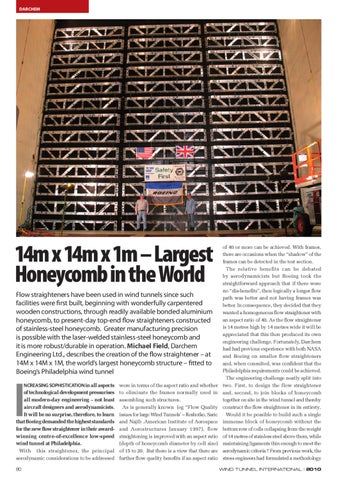DARCHEM
14m x 14m x 1m – Largest Honeycomb in the World Flow straighteners have been used in wind tunnels since such facilities were first built, beginning with wonderfully carpentered wooden constructions, through readily available bonded aluminium honeycomb, to present-day top-end flow straighteners constructed of stainless-steel honeycomb. Greater manufacturing precision is possible with the laser-welded stainless-steel honeycomb and it is more robust/durable in operation. Michael Field, Darchem Engineering Ltd., describes the creation of the flow straightener – at 14M x 14M x 1M, the world’s largest honeycomb structure – fitted to Boeing’s Philadelphia wind tunnel
i
ncreAsinG sophisticAtion in all aspects of technological development pressurises all modern-day engineering – not least aircraft designers and aerodynamicists. It will be no surprise, therefore, to learn that Boeing demanded the highest standards for the new flow straightener in their awardwinning centre-of-excellence low-speed wind tunnel at Philadelphia.
were in terms of the aspect ratio and whether to eliminate the frames normally used in assembling such structures. As is generally known (eg “Flow Quality issues for large Wind Tunnels’ – Reshotko, Saric and Najib .American Institute of Aerospace and Aerostructures January 1997), flow straightening is improved with an aspect ratio (depth of honeycomb diameter by cell size) With this straightener, the principal of 15 to 20. But there is a view that there are aerodynamic considerations to be addressed further flow quality benefits if an aspect ratio 80
of 40 or more can be achieved. With frames, there are occasions when the “shadow” of the frames can be detected in the test section. The relative benefits can be debated by aerodynamicists but Boeing took the straightforward approach that if there were no “dis-benefits”, then logically a longer flow path was better and not having frames was better. In consequence, they decided that they wanted a homogeneous flow straightener with an aspect ratio of 40. As the flow straightener is 14 metres high by 14 metres wide it will be appreciated that this then produced its own engineering challenge. Fortunately, Darchem had had previous experience with both NASA and Boeing on smaller flow straighteners and, when consulted, was confident that the Philadelphia requirements could be achieved. The engineering challenge neatly split into two. First, to design the flow straightener and, second, to join blocks of honeycomb together on site in the wind tunnel and thereby construct the flow straightener in its entirety. Would it be possible to build such a single immense block of honeycomb without the bottom row of cells collapsing from the weight of 14 metres of stainless steel above them, while maintaining ligaments thin enough to meet the aerodynamic criteria ? From previous work, the stress engineers had formulated a methodology WIND TUNNEL INTERNATIONAL | 2010
